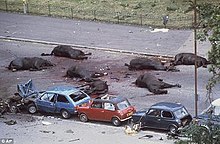Hyde Park and Regent's Park bombings
| Hyde Park and Regent's Park bombings | |
|---|---|
| Part of the Troubles | |

Aftermath of the Hyde Park bombing which killed four soldiers
|
|
| Location | London, England |
| Coordinates | 51°31′35″N 0°09′27″W / 51.52652°N 0.157443°WCoordinates: 51°31′35″N 0°09′27″W / 51.52652°N 0.157443°W |
| Date | 20 July 1982 |
| Target | British military |
|
Attack type
|
Bombings |
| Deaths | 11 |
|
Non-fatal injuries
|
c. 50 |
| Perpetrators | Provisional Irish Republican Army |
The Hyde Park and Regent's Park bombings occurred on 20 July 1982 in London. Members of the Provisional Irish Republican Army (IRA) detonated two bombs during British military ceremonies in Hyde Park and Regent's Park, both in central London.
The explosions killed 11 military personnel: four soldiers of the Blues & Royals at Hyde Park, and seven bandsmen of the Royal Green Jackets at Regent's Park. Seven of the Blues & Royals' horses also died in the attack. One seriously injured horse, Sefton, survived and was subsequently featured on television programmes and was awarded "Horse of the Year".
In 1987, Gilbert "Danny" McNamee was convicted of making the Hyde Park bomb and jailed for 25 years. He served 12 years before being released under the terms of the Good Friday Agreement; his conviction was later quashed. In 2013, John Downey was charged with four counts of murder in relation to the Hyde Park attack; his trial began in January 2014 but collapsed the following month after a ruling upon a letter sent to him by police assuring him that he would not be prosecuted over the attack. No one has ever been charged in connection with the Regent's Park bombing.
At 10:40 am, a nail bomb exploded in the boot of a blue Morris Marina parked on South Carriage Drive in Hyde Park. The bomb comprised 25 lb (11 kg) of gelignite and 30 lb (14 kg) of nails. It exploded as soldiers of the Household Cavalry, Queen Elizabeth II's official bodyguard regiment, were passing. They were taking part in their daily Changing of the Guard procession from their barracks in Knightsbridge to Horse Guards Parade. Three soldiers of the Blues & Royals were killed outright, and another, their standard-bearer, died from his wounds three days later. The other soldiers in the procession were badly wounded, and a number of civilians were injured. Seven of the regiment's horses were also killed or had to be euthanised because of their injuries. Explosives experts believed that the Hyde Park bomb was triggered by remote by an IRA member inside the park.
...
Wikipedia
